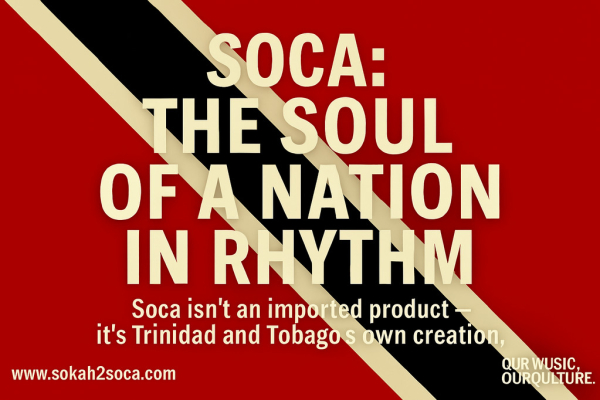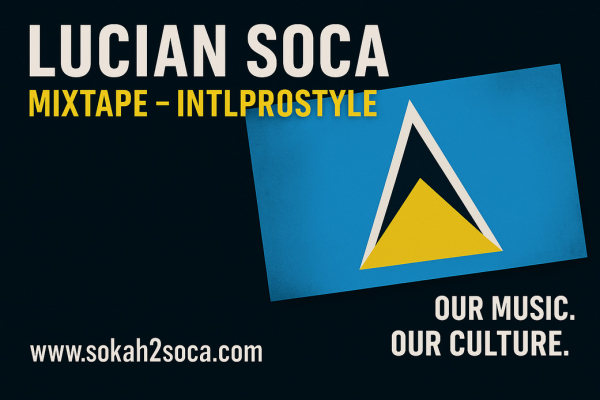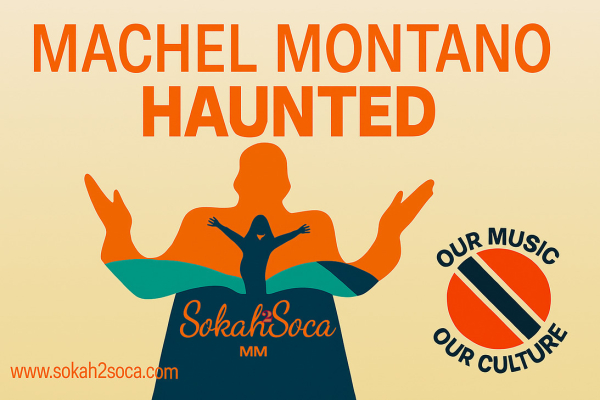This post first appeared on Sokah2Soca, where Caribbean music meets wit, rhythm, and real talk. Island Vybe Radio spins the tunes—we decode the culture.
Rather than simply copying the global perspective, we took a different approach. We took the main topics discussed and reimagined them through a Trinidadian lens—rich with cultural nuance, humor, and pride. This post isn’t just an info dump; it’s an affirmation. We explored:
What Is Soca?
What Does Soca Sound Like?
Soca and Calypso: Similar but Not the Same
The Origins of Soca
Garfield Blackman aka Lord Shorty
How Did Soca Develop?
What follows is a Sokah2Soca original—one part cultural homage, one part rhythmic manifesto. Play with the words. This is 'we story.'
Ok, to put it in true, boldfaced Trini terminology: I am asserting that Soca originated from our culture. It belongs to us, and it sings so beautifully. We are not selfish people; we gave it to you, and we gave it to the world. You are welcome!
What Is Soca?
Soca isn’t just a music genre—it’s a movement, a mindset, a flag flying high for Trinidad’s spirit. Born out of a need to evolve, express, and unify, Soca stands for the “Soul of Calypso,” not "Soul Calypso!" It’s Trinidad and Tobago talking back to the world with rhythm, resistance, and revelry. Not content to stay static, Soca embodies the creativity of a people constantly remixing their story. When you hear Soca, you’re not just vibing—you’re participating in a living, breathing culture.
What Does Soca Sound Like?
Soca sounds like sweat glistening in the sun. Like iron bending under rhythm. Like foot soles hitting asphalt on Carnival Tuesday. The genre has evolved, spawning variations like Groovy Soca, Power Soca, and Soca Chutney—but the core remains: energetic, infectious, and kinetic. It’s the sound of joy engineered for movement. Soca makes your chest bounce and your hands find the sky. Bass deep, snares sharp, vocals full of urgency and sweetness—it’s Trinidadian time travel in stereo.
?Soca and Calypso: Similar but Not the Same
Soca owes everything to Calypso, but it’s not a clone. Calypso speaks; Soca explores style and happiness. Calypso holds a position of authority, while Soca represents the youthful spirit. Both are lyrical forms born of struggle and satire, but while Calypso leans into storytelling and commentary, Soca leans into adrenaline. Think of it like 'mas': Calypso represents a traditional fancy sailor, while Soca embodies frontline feathers and paint. Yet they dance together—Soca often borrows Calypso’s cleverness, and Calypso benefits from Soca’s modern shine.
The Origins of Soca
It didn’t just drop out of the sky. Soca was born out of tension—between cultures, musical styles, and generations. Trinidad in the early '70s was a mash-up of African and East Indian heritage, and the music didn’t always reflect that fusion. Enter the experimenters—those who questioned the status quo and heard possibilities in every beat. Soca was the answer to “How do we evolve our sound while staying true to our roots?” Only a place like Trinidad could pose and successfully respond to this question. Having said that, we are going to talk about Garfield Blackman next. He is credited for creating the music. He was the innovator, experimenting with Calypso and Indian rhythms. He is credited mainly because he named the genre. One man is not an island; the people who helped with the creation, such as Pelham Goddard, King Wellington, and Winston Bailey (Shadow), all played a part. However, history will never be kind to them, so keep that in mind.
Garfield Blackman aka Lord Shorty
If Soca were a kingdom, Garfield Blackman would be its architect, not just its king. Dubbed Lord Shorty, he was Calypso royalty—no, he was the Calypso Bad-Boy, who dared to break tradition. In 1973, he fused Calypso with Indian rhythms and birthed the track “Indrani,” a proto-Soca anthem. But he didn’t stop there. He spent years refining the sound, labeling it "Sokah," and insisting it was more than a party starter—it was a symbol of cultural unity. Without Shorty, Soca wouldn’t just be missing a figurehead—it might not exist at all. Just think about this for a minute: if Shorty did not give the music a name, it may have been labeled "Modern Calypso"! Despite my deep-seated belief that many others deserve recognition, Shorty's foresight in naming the music has led to the creation of the genre known as "Soca."
How Did Soca Develop?
Soca is a shapeshifter. Well, let's start with that. From the beginning, change was in play. He named his music "Sokah" to give relevance to the use of Indian musical elements. However, incorrect spelling in the local newspaper resulted in "Soca!" Shory stated that it did not bother him, and he never sought to correct it because everyone was talking about "Soca." What began as cultural alchemy soon absorbed elements of funk, disco, reggae, dancehall, and EDM. Innovators across the Caribbean gave new meaning and new life to this ever-evolving new music. Nailah Blackman (Shorty’s granddaughter, no less) built off that foundation, keeping Soca fluid, fresh, and global. Today, Soca isn’t confined to Carnival season—it’s the soundtrack of Caribbean pride, diaspora connection, and digital identity. From Trinidad to Toronto, it pulses strong.
The Dominance of Soca at Carnival
If Carnival is the heartbeat of Trinidad, Soca is the blood rushing through its veins. Calypso may crown the monarchs, but Soca commands the masses. The road, the fetes, the trucks—they belong to Soca. Its dominance isn’t just commercial; it’s spiritual. Soca gives the masquerader permission to let go, transcend, and become. In the hours between J’ouvert and Last Lap, Soca isn’t just popular music—it’s the gospel of joy, and Trinidad is its cathedral.
We hope that after reading each paragraph you come away feeling satisfied. We chose short discourses so as not to overwhelm you with unnecessary diatribes. Hmm, I always tell people, "If the priest could play, who am I?" Calypso is sweet, but Soca has a powerful energy, and I do not consider myself a preacher! There will be a follow-up post that will stick to the ideas presented here but will adopt a different style, which will be published in the next post. Share your thoughts with us.
Lucian Soca 2025: DJ IntlProstyle's Sonic Salute to Saint Lucia Carnival
By Ananda/Sokah2SocaThis post first appeared on Sokah2Soca, where Caribbean music meets wit, rhythm, and real talk. Island Vybe Radio spins the tunes—we decode the culture.
The Greatest Bend Over (Take It Easy) Remix: A Step Forward or Just a Shinier Repeat?
By Ananda/Sokah2SocaThe content was first published on the blog Sokah2Soca (www.sokah2soca.com). We bring you only the best new music, while Island Vybe Radio rocks it live on the air!
- Improved visuals: The production value finally matches the energy of the track.
- Sean Paul’s cameo: A strategic move that boosts exposure and gives the remix crossover appeal.
- Yung Bredda’s consistency: He remains the focal point, holding his own even with a legend in the frame.
- The remix itself: While the video shines, the musical arrangement doesn’t stray far from the original. Is it a true reinvention or just a polished repackage?
- Sean Paul’s role is a cameo, which some fans feel lacks the vocal presence or lyrical interplay they expected or more of Sean Paul in the song, especially at the end of the song.
- Luna (the girl from the original video) is missing from this new music video. Are you upset that she was not included?
Haunted by Bacchanal: When Carnival Fellings Refuse to Let Go
By Ananda/Sokah2SocaThe content was first published on the blog Sokah2Soca (www.sokah2soca.com). We bring you only the best new music, while Island Vybe Radio rocks it live on the air!
- Your skin still tingles from the road.
- Your ears ring with rhythm and musical riddims.
- Your soul refuses to return to nine-to-five reality.





